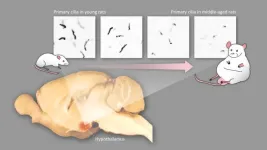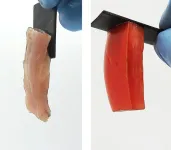(Press-News.org) ATLANTA – New data provided by studying the beluga whales at Georgia Aquarium helps close a key information gap about how much food these whales need to thrive. The information will inform important management decisions for their counterparts in Alaska’s Cook Inlet, which are protected under the U.S. Endangered Species Act (ESA).
A new study released in the Journal of Experimental Biology, led by Terrie M. Williams, Director of the Integrative Carnivore EcoPhysiology Lab, with her graduate student Jason John at the University of California-Santa Cruz in partnership with Georgia Aquarium, reveals that the whales’ unique metabolism and elevated caloric needs may limit their ability to escape from potential human disturbances.
The Cook Inlet beluga population was listed as endangered in 2008 due to a decline from over-harvesting by Alaska’s native hunters. But despite a cessation in whaling and other efforts to help the population recover, their numbers have not increased, and it is unknown why.
Difficulty collecting this type of data on belugas in the wild has made it hard for scientists to identify why they have failed to recover from excessive harvest. This study, which started in 2018, was a collaboration between U.C. Santa Cruz and Georgia Aquarium with the Alaska Region of NOAA Fisheries, which has management authority for Cook Inlet belugas. Scientists collected data about energy output from the aquarium’s one adult male and two adult female belugas while resting in metabolic domes, during submerged swimming, and when diving for food.
“We are losing large wild species all over the world,” said Williams. “One way that we might be able to prevent wholesale extinctions is to do the basic science that allows us to predict what these animals need to live in this crazy, changing world.”
“This study is one element we can do here to create a better understanding of how these animals take in and use energy,” said Dennis Christen, Georgia Aquarium’s Senior Director, Mammals and Birds. “That’s a measurement that’s nearly impossible to get in the wild. By understanding their metabolism, we can get an understanding of what they have to feed on in the wild and whether it is enough.”
“Taking these baseline measurements – which are the gold standard for conservation modeling – helps us to understand how these whales are built,” Williams explained. “There aren’t many facilities like Georgia Aquarium that have the capabilities and research mindset to conduct this type of research.”
Georgia Aquarium scientists prepared the belugas for the study over a six-month period, using positive reinforcement and operant conditioning techniques to measure their resting and active metabolic rates in different states. Open flow respirometry was used to measure oxygen consumption using a plexiglass dome for the animals to breathe in, and accelerometers were used to measure movement and swim stroke rates in the water.
Data gleaned from this research will help create predictive energy models to evaluate the potential impact of human activities on beluga whales, and a close relative, Arctic narwhals.
The metabolic study conducted by this collaboration is helping to inform measures to ensure Cook Inlet belugas have adequate resources to fuel their caloric needs. Under the ESA, any action that is funded or permitted by the federal government that has the potential to impact a threatened or endangered species must be reviewed. This includes activities like oil and gas exploration and development, marine construction, and commercial fishing. This review includes mitigations to reduce impacts on ESA species. Obtaining a baseline on the calorie needs of Cook Inlet belugas will help inform these mitigations to reduce the effects of these activities on Cook Inlet belugas.
“Wild belugas typically use the calories from ingesting fish to fuel growth, activity, maintaining their health and reproducing,” said Williams. “With increased human disturbance, calories will have to be diverted to respond to perceived threats. Such energy imbalance cannot be sustained for long periods without negative consequences.”
“The whales at Georgia Aquarium are ambassadors for their species. Getting the opportunity to participate in a research study like this one means a lot,” said Katie Flammer, associate curator, Mammals and Birds. “These animals, and our training team, are helping beluga whales globally.”
To learn more about Georgia Aquarium’s conservation work, click here.
###
ABOUT THE JOSEPH M. LONG MARINE LABORATORY/UC-SANTA CRUZ
The Joseph M. Long Marine Laboratory (LML) provides a state-of-the-art home for interdisciplinary research and teaching on marine life, coastal conservation, climate change impacts and other marine and coastal science issues. LML is world-renowned for innovative research in coastal ecology, marine vertebrates and invertebrates, and marine mammal studies in the lab and field, including physiology, sensory reception, behavior and bioacoustics.
ABOUT GEORGIA AQUARIUM
Georgia Aquarium is a leading 501(c)(3) non-profit organization located in Atlanta, Ga. that is Humane Certified by American Humane and accredited by the Alliance of Marine Mammal Parks and Aquariums and the Association of Zoos and Aquariums. Georgia Aquarium is committed to working on behalf of all marine life through education, preservation, exceptional animal care, and research across the globe. Georgia Aquarium continues its mission each day to inspire, educate, and entertain its millions of guests about the aquatic biodiversity throughout the world through its engaging exhibits and tens of thousands of animals across its eight major galleries.
Media Contact:
Paige Hale / Georgia Aquarium / Phale@georgiaaquarium.org
END
New research at Georgia Aquarium helps conserve endangered beluga whales in Alaska
Metabolic and caloric measurements show belugas have big caloric needs to maintain their cold-water lifestyle
2024-03-13
ELSE PRESS RELEASES FROM THIS DATE:
Federal housing programs protect residents from lead exposure
2024-03-13
Americans already living in housing supported by federal housing assistance programs have significantly lower blood lead levels than counterparts who would later join these programs, according to new research led by environmental health scientists at Columbia University Mailman School of Public Health and Tufts Medical Center. The findings appear in the peer-reviewed journal Environmental Health Perspectives.
“Living in federally-supported housing—especially public housing—limited opportunities for residents’ exposure to lead,” says first author MyDzung Chu, Ph.D., assistant professor in the Institute for ...
Curbing coal-burning emissions translates to health gains for children
2024-03-13
Residential heating by coal has for decades been the major contributor to the high levels of air pollution in Krakow, Poland. New research finds a nearly 40 percent decline in the annual average concentration of respirable particulate matter (PM2.5) in Kraków, Poland, between 2010 and 2019 following the implementation of policies targeting emissions from the burning of coal and other solid fuels. Researchers show the improvement in air quality translated to substantial benefits for children’s outcomes, including fewer cases of asthma and better birth outcomes.
The ...
Middle-age obesity is caused by changes in the shape of neurons in the brain
2024-03-13
Nagoya University researchers and their colleagues in Japan have found that middle-age obesity is caused by age-related changes in the shape of neurons in the hypothalamus, a region of the brain that controls metabolism and appetite.
A protein called melanocortin-4 receptor (MC4R) detects overnutrition and regulates metabolism and appetite to prevent obesity. According to their study in rats, MC4Rs were concentrated in primary cilia (antenna-like structures) that extend from a couple of groups of hypothalamic neurons. The study also showed that the primary cilia became shorter with age, which decreased MC4Rs accordingly, ...
2023 Nano Research Young Innovators (NR45) Awards in Bio-inspired Nanomaterials
2024-03-13
Recently, Nano Research announced awardees of the 2023 Nano Research Young Innovators (NR45) Awards in Bio-inspired Nanomaterials. Thirty-three outstanding young investigators under the age of 45 were selected for their extraordinary contributions in developing bio-inspired nanomaterials with applications spanning clean energy, human healthcare, monitoring, and disease treatments. They were selected through a competitive process by an award committee from Nano Research’s editorial board. Congratulations to all the 33 awardees in 2023!
The NR45 Awards ...
KIMM finds solution to medical waste problem, which has become a major national issue
2024-03-13
A medical waste treatment system, which is capable of 99.9999 percent sterilization by using high-temperature and high-pressure steam, has been developed for the first time in the country.
The Korea Institute of Machinery and Materials (President Seog-Hyeon Ryu, hereinafter referred to as KIMM), an institute under the jurisdiction of the Ministry of Science and ICT, has succeeded in developing an on-site-disposal type medical waste sterilization system that can help to resolve the problem caused by medical waste, which has become a national and social issue as the volume of medical waste continues ...
UNIST researchers uncover revolutionary phenomenon in liquid crystals
2024-03-13
A research team, affiliated with UNIST, has unveiled for the first time a new principle of motion in the microworld, where objects can move in a directed manner simply by changing their sizes periodically within a substance known as liquid crystal. Led by Professor Jonwoo Jeong and his research team in the Department of Physics at UNIST, this discovery is poised to have far-reaching implications across various research fields, including the potential development of miniature robots in the future.
In their research, the team observed that air bubbles within ...
Study tracks shifts in student mental health during college
2024-03-13
A four-year study by Dartmouth researchers captures the most in-depth data yet on how college students' self-esteem and mental health fluctuates during their four years in academia, identifying key populations and stressors that the researchers say administrators could target to improve student well-being.
The study also provides among the first real-time accounts of how the coronavirus pandemic affected students' behavior and mental health. The stress and uncertainty of COVID-19 resulted in long-lasting behavioral changes that persisted as a "new normal" even as the pandemic diminished, including feeling more stressed, less socially engaged, and sleeping more.
The ...
Recreational activities such as golfing, gardening may be associated with increased ALS risk among men
2024-03-13
Participation in recreational activities — including golfing, gardening or yard work, woodworking and hunting — may be associated with an increase in a person’s risk for developing amyotrophic lateral sclerosis, or ALS, a Michigan Medicine study finds.
While many activities were associated with increased ALS risk, several were sex specific. The results are published in the Journal of the Neurological Sciences.
“We know that occupational risk factors, like working in manufacturing and trade industries, are linked to an increased risk for ALS, and this adds to a growing literature that recreational activities may also represent ...
You don’t need glue to hold these materials together — just electricity
2024-03-13
Is there a way to stick hard and soft materials together without any tape, glue or epoxy? A new study published in ACS Central Science shows that applying a small voltage to certain objects forms chemical bonds that securely link the objects together. Reversing the direction of electron flow easily separates the two materials. This electroadhesion effect could help create biohybrid robots, improve biomedical implants and enable new battery technologies.
When an adhesive is used to attach two things, it binds the surfaces either through mechanical or electrostatic forces. But sometimes those attractions or bonds are difficult, if not ...
Heart disease risk factors of modern lifestyles threaten extremely poor people living in low- and middle-income countries
2024-03-13
A new study reveals that many people living in extreme poverty in low- and middle-income countries (LMICs) have conditions that lead to heart disease, the world’s #1 cause of death — overturning ‘conventional wisdom’.
In the largest analysis of its kind exploring the relationship between poverty and cardiovascular disease (CVD) risk factors, experts discovered a high prevalence of hypertension, diabetes, smoking, obesity, and dyslipidemia in LMICs regardless of income —yet most adults living in extreme poverty were not treated for these CVD-related conditions.
An international group of researchers note that their findings, ...
LAST 30 PRESS RELEASES:
Sports injuries sustained during your period might be more severe
World's first successful 2 Tbit/s free-space optical communication using small optical terminals mountable on satellites and HAPS
Can intimate relationships affect your heart? New study says ‘yes’
Scalable and healable gradient textiles for multi‑scenario radiative cooling via bicomponent blow spinning
Research shows informed traders never let a good climate crisis go to waste
Intelligent XGBoost framework enhances asphalt pavement skid resistance assessment
Dual-function biomaterials for postoperative osteosarcoma: Tumor suppression and bone regeneration
New framework reveals where transport emissions concentrate in Singapore
NTP-enhanced lattice oxygen activation in Ce-Co catalysts for low-temperature soot combustion
Synergistic interface engineering in Cu-Zn-Ce catalysts for efficient CO2 hydrogenation to methanol
COVID-19 leaves a lasting mark on the human brain
Scientists use ultrasound to soften and treat cancer tumors without damaging healthy tissue
Community swimming program for Black youth boosts skills, sense of belonging, study finds
Specific depressive symptoms in midlife linked to increased dementia risk
An ‘illuminating’ design sheds light on cholesterol
Who is more likely to get long COVID?
Study showcases resilience and rapid growth of “living rocks”
Naval Research Lab diver earns Office of Naval Research 2025 Sailor of the Year
New Mayo-led study establishes practical definition for rapidly progressive dementia
Fossil fuel industry’s “climate false solutions” reinforce its power and aggravate environmental injustice
Researchers reveal bias in a widely used measure of algorithm performance
Alcohol causes cancer. A study from IOCB Prague confirms damage to DNA and shows how cells defend against it
Hidden viruses in wastewater treatment may shape public health risks, study finds
Unlock the power of nature: how biomass can transform climate mitigation
Biochar reshapes hidden soil microbes that capture carbon dioxide in farmland
Reducing saturated fat intake shows mortality benefit, but only in high-risk individuals
Manta rays create mobile ecosystems, study finds
Study: Mixed results in using lipoic acid to treat progressive multiple sclerosis
Norbert Holtkamp appointed director of Fermi National Accelerator Laboratory
New agentic AI platform accelerates advanced optics design
[Press-News.org] New research at Georgia Aquarium helps conserve endangered beluga whales in AlaskaMetabolic and caloric measurements show belugas have big caloric needs to maintain their cold-water lifestyle




